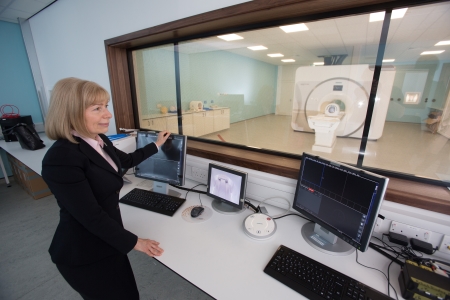The University of Glasgow officially opens its new £32m imaging centre of excellence (ICE) this week.
The unique medical research facility, which was built in collaboration with NHS Greater Glasgow and Clyde (NHSGGC) and with £16m funding from the Medical Research Council and Glasgow City Region City Deal, was opened by the chief executive designate of UK Research and Innovation (UKRI), Professor Sir Mark Walport.
ICE brings together world-leading research, cutting-edge technology and international business investment under one roof and will act as a hub for translating science into economic and patient benefit for Glasgow, Scotland, and across the UK. <.p>
The project will bring 396 new high-value jobs to the city over a seven-year period and has been independently assessed to contribute £88m to the local economy.
With aims to become a global centre of excellence for precision medicine, the building is already home to Scotland’s first seven7 Tesla MRI scanner – the first of its kind in the UK in a clinical setting. The scanner will be a focus of research for clinical and non-clinical academic imaging specialists and clinical physics expertise.
The state-of-the-art building will also house the Clinical Innovation Zone, a space dedicated to biomedical companies, which will facilitate industry collaborations and the development of innovative healthcare technology. There will also be a further floor of neuro operating theatres, which will be funded by the NHS GGC.
The Clinical Innovation Zone has already attracted international small and medium-size enterprises (SMEs) from around the world, including Germany and Singapore.
ICE is one of three projects in the Glasgow City Region City Deal’s Innovation and Growth theme, alongside MediCity and The Tontine, Centre for Business Incubation and Development in the Merchant City.
Professor Dame Anna Dominiczak, vice principal and head of the College of Medical, Veterinary and Life Sciences, said: “ICE will be a world-leading example of a precision medicine centre, bringing together the key partners of the University of Glasgow, the NHS, and industry together to further clinical research and ultimately bring economic and patient benefits not only for Glasgow, but to the whole of Scotland.
“ICE isn’t about ivory tower research.It is about bringing world-leading clinical academics together with industry to collaborate and to create something that, not only positively benefits patients, but also brings a meaningful economic benefit as well.”
Councillor Frank McAveety, leader of Glasgow City Council and chairman of the Glasgow City Region Cabinet, added: “Glasgow is one of the world’s-most-innovative cities – with both a proud history and a bright future in life sciences and new technologies.
“This fantastic new facility is a great example of how our ground-breaking Glasgow City Region City Deal is already helping to reinforce that global reputation – while delivering jobs, infrastructure, and a whole range of other economic and social benefits.”
And Robert Calderwood, chief executive of NHS Greater Glasgow and Clyde, said: “The opening of this new building is a further step in the collaboration between the NHS and the University of Glasgow to provide world-leading research and cutting-edge technology which will benefits patients across Scotland and beyond.
“ICE provided us the opportunity to develop four state-of-the-art theatres with full ancillary accommodation which will be utilised by the department of neurosurgery and oral maxillofacial surgery.
“It will also provide the most-advanced imaging facilities in the world on the Queen Elizabeth University Hospital campus.”

